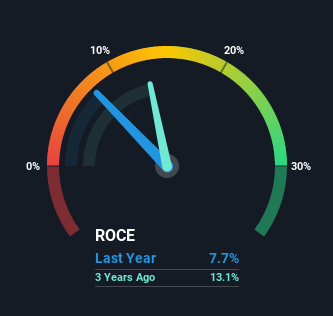Here's What's Concerning About Smith & Nephew's (LON:SN.) Returns On Capital
There are a few key trends to look for if we want to identify the next multi-bagger. Firstly, we'll want to see a proven return on capital employed (ROCE) that is increasing, and secondly, an expanding base of capital employed. Basically this means that a company has profitable initiatives that it can continue to reinvest in, which is a trait of a compounding machine. Having said that, from a first glance at Smith & Nephew (LON:SN.) we aren't jumping out of our chairs at how returns are trending, but let's have a deeper look.
What is Return On Capital Employed (ROCE)?
For those who don't know, ROCE is a measure of a company's yearly pre-tax profit (its return), relative to the capital employed in the business. The formula for this calculation on Smith & Nephew is:
Return on Capital Employed = Earnings Before Interest and Tax (EBIT) ÷ (Total Assets - Current Liabilities)
0.077 = US$677m ÷ (US$11b - US$2.1b) (Based on the trailing twelve months to July 2021).
Thus, Smith & Nephew has an ROCE of 7.7%. Ultimately, that's a low return and it under-performs the Medical Equipment industry average of 11%.
Check out our latest analysis for Smith & Nephew
In the above chart we have measured Smith & Nephew's prior ROCE against its prior performance, but the future is arguably more important. If you'd like to see what analysts are forecasting going forward, you should check out our free report for Smith & Nephew.
What Can We Tell From Smith & Nephew's ROCE Trend?
When we looked at the ROCE trend at Smith & Nephew, we didn't gain much confidence. To be more specific, ROCE has fallen from 14% over the last five years. However it looks like Smith & Nephew might be reinvesting for long term growth because while capital employed has increased, the company's sales haven't changed much in the last 12 months. It's worth keeping an eye on the company's earnings from here on to see if these investments do end up contributing to the bottom line.
The Key Takeaway
Bringing it all together, while we're somewhat encouraged by Smith & Nephew's reinvestment in its own business, we're aware that returns are shrinking. Unsurprisingly, the stock has only gained 12% over the last five years, which potentially indicates that investors are accounting for this going forward. As a result, if you're hunting for a multi-bagger, we think you'd have more luck elsewhere.
Like most companies, Smith & Nephew does come with some risks, and we've found 1 warning sign that you should be aware of.
While Smith & Nephew may not currently earn the highest returns, we've compiled a list of companies that currently earn more than 25% return on equity. Check out this free list here.
Have feedback on this article? Concerned about the content? Get in touch with us directly. Alternatively, email editorial-team (at) simplywallst.com.
This article by Simply Wall St is general in nature. We provide commentary based on historical data and analyst forecasts only using an unbiased methodology and our articles are not intended to be financial advice. It does not constitute a recommendation to buy or sell any stock, and does not take account of your objectives, or your financial situation. We aim to bring you long-term focused analysis driven by fundamental data. Note that our analysis may not factor in the latest price-sensitive company announcements or qualitative material. Simply Wall St has no position in any stocks mentioned.

 Yahoo Finance
Yahoo Finance 
